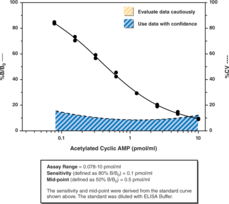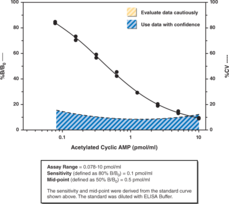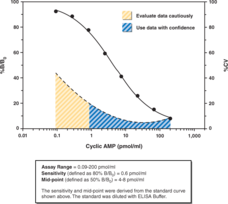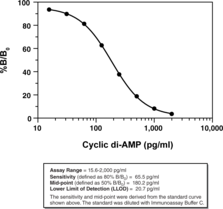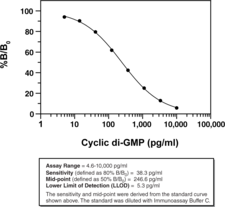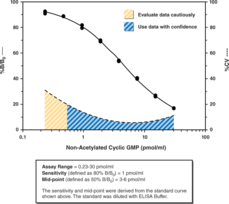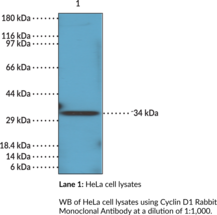Cayman
Showing 16651–16800 of 45550 results
-
Cyanidin 3-O-glucoside is a natural anthocyanin found in the fruits of some plants.{26793} Technically known as cyanidin 3-O-β-glucopyranoside, this polyphenolic compound scavenges superoxide anion radicals (IC50 = 69 µM) and protects neurons from oxidative stress.{26793,26794} Also, cyanidin 3-O-glucoside inhibits the ADP-ribosyl cyclase CD38 (IC50 = 6.3 µM), preventing the metabolism of NAD+ and NADP+.{26796,26795}
Brand:CaymanSKU:-Out of stock
-
Cyanidin 3-O-glucoside is a natural anthocyanin found in the fruits of some plants.{26793} Technically known as cyanidin 3-O-β-glucopyranoside, this polyphenolic compound scavenges superoxide anion radicals (IC50 = 69 µM) and protects neurons from oxidative stress.{26793,26794} Also, cyanidin 3-O-glucoside inhibits the ADP-ribosyl cyclase CD38 (IC50 = 6.3 µM), preventing the metabolism of NAD+ and NADP+.{26796,26795}
Brand:CaymanSKU:-Out of stock
-
Cyanidin 3-O-β-D-galactopyranoside is an anthocyanin flavonoid pigment that has been found in P. vera and has antioxidant properties.{49009,49010,49011} It scavenges radicals in 2,2-diphenyl-1-picrylhyrazyl (DPPH; Item No. 14805), Trolox equivalent antioxidant capacity (TEAC), superoxide anion, and hydrogen peroxide assays.{49011} Cyanidin 3-O-β-D-galactopyranoside decreases the release of lactate dehydrogenase (LDH) and the activation of caspase-3 in lymphocytes with t-butyl hydroperoxide-induced oxidative damage.
Brand:CaymanSKU:22264 -Out of stock
-
Cyanidin 3-O-β-D-galactopyranoside is an anthocyanin flavonoid pigment that has been found in P. vera and has antioxidant properties.{49009,49010,49011} It scavenges radicals in 2,2-diphenyl-1-picrylhyrazyl (DPPH; Item No. 14805), Trolox equivalent antioxidant capacity (TEAC), superoxide anion, and hydrogen peroxide assays.{49011} Cyanidin 3-O-β-D-galactopyranoside decreases the release of lactate dehydrogenase (LDH) and the activation of caspase-3 in lymphocytes with t-butyl hydroperoxide-induced oxidative damage.
Brand:CaymanSKU:22264 -Out of stock
-
Cyanidin 3-O-β-D-galactopyranoside is an anthocyanin flavonoid pigment that has been found in P. vera and has antioxidant properties.{49009,49010,49011} It scavenges radicals in 2,2-diphenyl-1-picrylhyrazyl (DPPH; Item No. 14805), Trolox equivalent antioxidant capacity (TEAC), superoxide anion, and hydrogen peroxide assays.{49011} Cyanidin 3-O-β-D-galactopyranoside decreases the release of lactate dehydrogenase (LDH) and the activation of caspase-3 in lymphocytes with t-butyl hydroperoxide-induced oxidative damage.
Brand:CaymanSKU:22264 -Out of stock
-
Brand:CaymanSKU:23078 - 1 g
Available on backorder
-
Brand:CaymanSKU:23078 - 100 mg
Available on backorder
-
Brand:CaymanSKU:23078 - 250 mg
Available on backorder
-
Brand:CaymanSKU:23078 - 500 mg
Available on backorder
-
Cyantraniliprole is an anthranilic diamide insecticide and an allosteric ryanodine receptor (RyR) activator.{47492} It induces calcium release from intracellular stores in Sf9 cells expressing H. virescens or D. melanogaster RyRs but not Sf9 cells that do not express RyRs. It is 300- to 500-fold selective for insect over mouse RyR1, greater than 2,000-fold selective for insect over rat RyR2, and inactive in human IMR32 cells expressing RyR2 and RyR3. It is active against insects of the order Lepidoptera, including the diamondback moth with a 50% plant protection value (PP50) of less than 0.1 ppm. It is also active against insects in the order Hemiptera, inducing mortality of the green peach aphid, cotton melon aphid, and white fly (EC50s = 1.1, 0.4, and 5.8 ppm, respectively). Formulations containing cyantraniliprole have been used as insecticides in greenhouse and nursery crops.
Brand:CaymanSKU:27309 - 10 mgAvailable on backorder
-
Cyantraniliprole is an anthranilic diamide insecticide and an allosteric ryanodine receptor (RyR) activator.{47492} It induces calcium release from intracellular stores in Sf9 cells expressing H. virescens or D. melanogaster RyRs but not Sf9 cells that do not express RyRs. It is 300- to 500-fold selective for insect over mouse RyR1, greater than 2,000-fold selective for insect over rat RyR2, and inactive in human IMR32 cells expressing RyR2 and RyR3. It is active against insects of the order Lepidoptera, including the diamondback moth with a 50% plant protection value (PP50) of less than 0.1 ppm. It is also active against insects in the order Hemiptera, inducing mortality of the green peach aphid, cotton melon aphid, and white fly (EC50s = 1.1, 0.4, and 5.8 ppm, respectively). Formulations containing cyantraniliprole have been used as insecticides in greenhouse and nursery crops.
Brand:CaymanSKU:27309 - 100 mgAvailable on backorder
-
Cyantraniliprole is an anthranilic diamide insecticide and an allosteric ryanodine receptor (RyR) activator.{47492} It induces calcium release from intracellular stores in Sf9 cells expressing H. virescens or D. melanogaster RyRs but not Sf9 cells that do not express RyRs. It is 300- to 500-fold selective for insect over mouse RyR1, greater than 2,000-fold selective for insect over rat RyR2, and inactive in human IMR32 cells expressing RyR2 and RyR3. It is active against insects of the order Lepidoptera, including the diamondback moth with a 50% plant protection value (PP50) of less than 0.1 ppm. It is also active against insects in the order Hemiptera, inducing mortality of the green peach aphid, cotton melon aphid, and white fly (EC50s = 1.1, 0.4, and 5.8 ppm, respectively). Formulations containing cyantraniliprole have been used as insecticides in greenhouse and nursery crops.
Brand:CaymanSKU:27309 - 25 mgAvailable on backorder
-
Cyantraniliprole is an anthranilic diamide insecticide and an allosteric ryanodine receptor (RyR) activator.{47492} It induces calcium release from intracellular stores in Sf9 cells expressing H. virescens or D. melanogaster RyRs but not Sf9 cells that do not express RyRs. It is 300- to 500-fold selective for insect over mouse RyR1, greater than 2,000-fold selective for insect over rat RyR2, and inactive in human IMR32 cells expressing RyR2 and RyR3. It is active against insects of the order Lepidoptera, including the diamondback moth with a 50% plant protection value (PP50) of less than 0.1 ppm. It is also active against insects in the order Hemiptera, inducing mortality of the green peach aphid, cotton melon aphid, and white fly (EC50s = 1.1, 0.4, and 5.8 ppm, respectively). Formulations containing cyantraniliprole have been used as insecticides in greenhouse and nursery crops.
Brand:CaymanSKU:27309 - 50 mgAvailable on backorder
-
CYC-116 is a potent Aurora kinase inhibitor exhibiting Ki values of 8.0 and 9.2 nM for Aurora kinases A and B, respectively.{33839} It is significantly less potent against a panel of cyclin-dependent kinases and other related kinases, with the exception of Flt-3 (Ki = 44 nM). CYC-116 exhibits broad-spectrum antiproliferative activity against a panel of human cancer cell lines with a mean IC50 value of 0.54 µM (range = 0.09 – 1.6 µM). It is orally bioavailable and inhibits the growth of human tumor xenografts in mice.
Brand:CaymanSKU:21205 -Out of stock
-
CYC-116 is a potent Aurora kinase inhibitor exhibiting Ki values of 8.0 and 9.2 nM for Aurora kinases A and B, respectively.{33839} It is significantly less potent against a panel of cyclin-dependent kinases and other related kinases, with the exception of Flt-3 (Ki = 44 nM). CYC-116 exhibits broad-spectrum antiproliferative activity against a panel of human cancer cell lines with a mean IC50 value of 0.54 µM (range = 0.09 – 1.6 µM). It is orally bioavailable and inhibits the growth of human tumor xenografts in mice.
Brand:CaymanSKU:21205 -Out of stock
-
CYC-116 is a potent Aurora kinase inhibitor exhibiting Ki values of 8.0 and 9.2 nM for Aurora kinases A and B, respectively.{33839} It is significantly less potent against a panel of cyclin-dependent kinases and other related kinases, with the exception of Flt-3 (Ki = 44 nM). CYC-116 exhibits broad-spectrum antiproliferative activity against a panel of human cancer cell lines with a mean IC50 value of 0.54 µM (range = 0.09 – 1.6 µM). It is orally bioavailable and inhibits the growth of human tumor xenografts in mice.
Brand:CaymanSKU:21205 -Out of stock
-
CYC-116 is a potent Aurora kinase inhibitor exhibiting Ki values of 8.0 and 9.2 nM for Aurora kinases A and B, respectively.{33839} It is significantly less potent against a panel of cyclin-dependent kinases and other related kinases, with the exception of Flt-3 (Ki = 44 nM). CYC-116 exhibits broad-spectrum antiproliferative activity against a panel of human cancer cell lines with a mean IC50 value of 0.54 µM (range = 0.09 – 1.6 µM). It is orally bioavailable and inhibits the growth of human tumor xenografts in mice.
Brand:CaymanSKU:21205 -Out of stock
-
Cyclic AMP (cAMP) is a central second messenger in cell signaling, propagating signals from receptors to downstream pathways. It is generated from ATP by several adenylate cyclase enzymes, which are modulated by G protein-coupled receptors.{16830} cAMP activates protein kinase A and the exchange proteins activated by cAMP (Epac1 and Epac2), which are nucleotide exchange factors for the Rap family of GTPases.{20516,23361} cAMP is degraded to AMP by cyclic nucleotide phosphodiesterases.{22521}
Brand:CaymanSKU:-Available on backorder
-
Cyclic AMP (cAMP) is a central second messenger in cell signaling, propagating signals from receptors to downstream pathways. It is generated from ATP by several adenylate cyclase enzymes, which are modulated by G protein-coupled receptors.{16830} cAMP activates protein kinase A and the exchange proteins activated by cAMP (Epac1 and Epac2), which are nucleotide exchange factors for the Rap family of GTPases.{20516,23361} cAMP is degraded to AMP by cyclic nucleotide phosphodiesterases.{22521}
Brand:CaymanSKU:-Available on backorder
-
Cyclic AMP (cAMP) is a central second messenger in cell signaling, propagating signals from receptors to downstream pathways. It is generated from ATP by several adenylate cyclase enzymes, which are modulated by G protein-coupled receptors.{16830} cAMP activates protein kinase A and the exchange proteins activated by cAMP (Epac1 and Epac2), which are nucleotide exchange factors for the Rap family of GTPases.{20516,23361} cAMP is degraded to AMP by cyclic nucleotide phosphodiesterases.{22521}
Brand:CaymanSKU:-Available on backorder
-
Brand:CaymanSKU:481002 - 100 dtn
Available on backorder
-
Brand:CaymanSKU:481002 - 500 dtn
Available on backorder
-
Cayman’s cAMP assay is a very sensitive competitive ELISA that permits cAMP measurements within the standard curve range of 0.078-10 pmol/ml, typically with a sensitivity (80% B/B0) of 0.1 pmol/ml once samples and standards have been acetylated prior to analysis. This assay has been validated with culture media, urine, tissue, and plasma samples. If you prefer to assay your samples and still achieve excellent sensitivity without the need to perform a pre-assay acetylation step we recommend using Cayman’s cAMP Select ELISA Kit. Cyclic AMP is a ubiquitous cellular second messenger that is a critical component of a signal transduction pathway linking membrane receptors and their ligands to the activation of internal cellular enzymatic activity and gene expression. cAMP is synthesized from ATP by membrane-bound adenylate cyclase. Binding of certain ligands or hormones to their specific G-protein couple receptors activates GTP binding proteins (Gs or Gi) which either stimulate or inhibit adenylate cyclase. cAMP activates or inhibits various enzymes or cascade of enzymes by promoting their phosphorylation or dephosphorylation. The cAMP signal is neutralized by hydrolysis of cAMP to AMP by phosphodiesterases. Therefore, the concentration of cAMP in a cell is a function of the ratio of the rate of synthesis from ATP by adenylate cyclase and its rate of breakdown to AMP by specific phosphodiesterases.
Brand:CaymanSKU:581001 - 480 solid wellsAvailable on backorder
-
Cayman’s cAMP assay is a very sensitive competitive ELISA that permits cAMP measurements within the standard curve range of 0.078-10 pmol/ml, typically with a sensitivity (80% B/B0) of 0.1 pmol/ml once samples and standards have been acetylated prior to analysis. This assay has been validated with culture media, urine, tissue, and plasma samples. If you prefer to assay your samples and still achieve excellent sensitivity without the need to perform a pre-assay acetylation step we recommend using Cayman’s cAMP Select ELISA Kit. Cyclic AMP is a ubiquitous cellular second messenger that is a critical component of a signal transduction pathway linking membrane receptors and their ligands to the activation of internal cellular enzymatic activity and gene expression. cAMP is synthesized from ATP by membrane-bound adenylate cyclase. Binding of certain ligands or hormones to their specific G-protein couple receptors activates GTP binding proteins (Gs or Gi) which either stimulate or inhibit adenylate cyclase. cAMP activates or inhibits various enzymes or cascade of enzymes by promoting their phosphorylation or dephosphorylation. The cAMP signal is neutralized by hydrolysis of cAMP to AMP by phosphodiesterases. Therefore, the concentration of cAMP in a cell is a function of the ratio of the rate of synthesis from ATP by adenylate cyclase and its rate of breakdown to AMP by specific phosphodiesterases.
Brand:CaymanSKU:581001 - 480 strip wellsAvailable on backorder
-
Cayman’s cAMP assay is a very sensitive competitive ELISA that permits cAMP measurements within the standard curve range of 0.078-10 pmol/ml, typically with a sensitivity (80% B/B0) of 0.1 pmol/ml once samples and standards have been acetylated prior to analysis. This assay has been validated with culture media, urine, tissue, and plasma samples. If you prefer to assay your samples and still achieve excellent sensitivity without the need to perform a pre-assay acetylation step we recommend using Cayman’s cAMP Select ELISA Kit. Cyclic AMP is a ubiquitous cellular second messenger that is a critical component of a signal transduction pathway linking membrane receptors and their ligands to the activation of internal cellular enzymatic activity and gene expression. cAMP is synthesized from ATP by membrane-bound adenylate cyclase. Binding of certain ligands or hormones to their specific G-protein couple receptors activates GTP binding proteins (Gs or Gi) which either stimulate or inhibit adenylate cyclase. cAMP activates or inhibits various enzymes or cascade of enzymes by promoting their phosphorylation or dephosphorylation. The cAMP signal is neutralized by hydrolysis of cAMP to AMP by phosphodiesterases. Therefore, the concentration of cAMP in a cell is a function of the ratio of the rate of synthesis from ATP by adenylate cyclase and its rate of breakdown to AMP by specific phosphodiesterases.
Brand:CaymanSKU:581001 - 96 solid wellsAvailable on backorder
-
Cayman’s cAMP assay is a very sensitive competitive ELISA that permits cAMP measurements within the standard curve range of 0.078-10 pmol/ml, typically with a sensitivity (80% B/B0) of 0.1 pmol/ml once samples and standards have been acetylated prior to analysis. This assay has been validated with culture media, urine, tissue, and plasma samples. If you prefer to assay your samples and still achieve excellent sensitivity without the need to perform a pre-assay acetylation step we recommend using Cayman’s cAMP Select ELISA Kit. Cyclic AMP is a ubiquitous cellular second messenger that is a critical component of a signal transduction pathway linking membrane receptors and their ligands to the activation of internal cellular enzymatic activity and gene expression. cAMP is synthesized from ATP by membrane-bound adenylate cyclase. Binding of certain ligands or hormones to their specific G-protein couple receptors activates GTP binding proteins (Gs or Gi) which either stimulate or inhibit adenylate cyclase. cAMP activates or inhibits various enzymes or cascade of enzymes by promoting their phosphorylation or dephosphorylation. The cAMP signal is neutralized by hydrolysis of cAMP to AMP by phosphodiesterases. Therefore, the concentration of cAMP in a cell is a function of the ratio of the rate of synthesis from ATP by adenylate cyclase and its rate of breakdown to AMP by specific phosphodiesterases.
Brand:CaymanSKU:581001 - 96 strip wellsAvailable on backorder
-
Cayman’s cAMP assay is a very sensitive competitive ELISA that permits cAMP measurements within the standard curve range of 0.078-10 pmol/ml, typically with a sensitivity (80% B/B0) of 0.1 pmol/ml once samples and standards have been acetylated prior to analysis. This assay has been validated with culture media, urine, tissue, and plasma samples. If you prefer to assay your samples and still achieve excellent sensitivity without the need to perform a pre-assay acetylation step we recommend using Cayman’s cAMP Select ELISA Kit. Cyclic AMP is a ubiquitous cellular second messenger that is a critical component of a signal transduction pathway linking membrane receptors and their ligands to the activation of internal cellular enzymatic activity and gene expression. cAMP is synthesized from ATP by membrane-bound adenylate cyclase. Binding of certain ligands or hormones to their specific G-protein couple receptors activates GTP binding proteins (Gs or Gi) which either stimulate or inhibit adenylate cyclase. cAMP activates or inhibits various enzymes or cascade of enzymes by promoting their phosphorylation or dephosphorylation. The cAMP signal is neutralized by hydrolysis of cAMP to AMP by phosphodiesterases. Therefore, the concentration of cAMP in a cell is a function of the ratio of the rate of synthesis from ATP by adenylate cyclase and its rate of breakdown to AMP by specific phosphodiesterases.
Brand:CaymanSKU:581002 - 480 solid wellsAvailable on backorder
-
Cayman’s cAMP assay is a very sensitive competitive ELISA that permits cAMP measurements within the standard curve range of 0.078-10 pmol/ml, typically with a sensitivity (80% B/B0) of 0.1 pmol/ml once samples and standards have been acetylated prior to analysis. This assay has been validated with culture media, urine, tissue, and plasma samples. If you prefer to assay your samples and still achieve excellent sensitivity without the need to perform a pre-assay acetylation step we recommend using Cayman’s cAMP Select ELISA Kit. Cyclic AMP is a ubiquitous cellular second messenger that is a critical component of a signal transduction pathway linking membrane receptors and their ligands to the activation of internal cellular enzymatic activity and gene expression. cAMP is synthesized from ATP by membrane-bound adenylate cyclase. Binding of certain ligands or hormones to their specific G-protein couple receptors activates GTP binding proteins (Gs or Gi) which either stimulate or inhibit adenylate cyclase. cAMP activates or inhibits various enzymes or cascade of enzymes by promoting their phosphorylation or dephosphorylation. The cAMP signal is neutralized by hydrolysis of cAMP to AMP by phosphodiesterases. Therefore, the concentration of cAMP in a cell is a function of the ratio of the rate of synthesis from ATP by adenylate cyclase and its rate of breakdown to AMP by specific phosphodiesterases.
Brand:CaymanSKU:581002 - 480 strip wellsAvailable on backorder
-
Cayman’s cAMP assay is a very sensitive competitive ELISA that permits cAMP measurements within the standard curve range of 0.078-10 pmol/ml, typically with a sensitivity (80% B/B0) of 0.1 pmol/ml once samples and standards have been acetylated prior to analysis. This assay has been validated with culture media, urine, tissue, and plasma samples. If you prefer to assay your samples and still achieve excellent sensitivity without the need to perform a pre-assay acetylation step we recommend using Cayman’s cAMP Select ELISA Kit. Cyclic AMP is a ubiquitous cellular second messenger that is a critical component of a signal transduction pathway linking membrane receptors and their ligands to the activation of internal cellular enzymatic activity and gene expression. cAMP is synthesized from ATP by membrane-bound adenylate cyclase. Binding of certain ligands or hormones to their specific G-protein couple receptors activates GTP binding proteins (Gs or Gi) which either stimulate or inhibit adenylate cyclase. cAMP activates or inhibits various enzymes or cascade of enzymes by promoting their phosphorylation or dephosphorylation. The cAMP signal is neutralized by hydrolysis of cAMP to AMP by phosphodiesterases. Therefore, the concentration of cAMP in a cell is a function of the ratio of the rate of synthesis from ATP by adenylate cyclase and its rate of breakdown to AMP by specific phosphodiesterases.
Brand:CaymanSKU:581002 - 96 solid wellsAvailable on backorder
-
Cayman’s cAMP assay is a very sensitive competitive ELISA that permits cAMP measurements within the standard curve range of 0.078-10 pmol/ml, typically with a sensitivity (80% B/B0) of 0.1 pmol/ml once samples and standards have been acetylated prior to analysis. This assay has been validated with culture media, urine, tissue, and plasma samples. If you prefer to assay your samples and still achieve excellent sensitivity without the need to perform a pre-assay acetylation step we recommend using Cayman’s cAMP Select ELISA Kit. Cyclic AMP is a ubiquitous cellular second messenger that is a critical component of a signal transduction pathway linking membrane receptors and their ligands to the activation of internal cellular enzymatic activity and gene expression. cAMP is synthesized from ATP by membrane-bound adenylate cyclase. Binding of certain ligands or hormones to their specific G-protein couple receptors activates GTP binding proteins (Gs or Gi) which either stimulate or inhibit adenylate cyclase. cAMP activates or inhibits various enzymes or cascade of enzymes by promoting their phosphorylation or dephosphorylation. The cAMP signal is neutralized by hydrolysis of cAMP to AMP by phosphodiesterases. Therefore, the concentration of cAMP in a cell is a function of the ratio of the rate of synthesis from ATP by adenylate cyclase and its rate of breakdown to AMP by specific phosphodiesterases.
Brand:CaymanSKU:581002 - 96 strip wellsAvailable on backorder
-
Brand:CaymanSKU:481004 - 1 ea
Available on backorder
-
Brand:CaymanSKU:401042 - 100 dtn
Available on backorder
-
Brand:CaymanSKU:401042 - 500 dtn
Available on backorder
-
Cayman’s cAMP Select assay is a competitive ELISA that permits cAMP measurements within the standard curve range of 0.09-200 pmol/ml and a sensitivity (80% B/B0) of approximately 0.6 pmol/ml. Acetylation of samples is not required in this highly sensitive assay where culture media, urine, tissue, and plasma samples have been validated. Cyclic AMP is a ubiquitous cellular second messenger that is a critical component of a signal transduction pathway linking membrane receptors and their ligands to the activation of internal cellular enzymatic activity and gene expression. cAMP is synthesized from ATP by membrane-bound adenylate cyclase. Binding of certain ligands or hormones to their specific G-protein couple receptors activates GTP binding proteins (Gs or Gi) which either stimulate or inhibit adenylate cyclase. cAMP activates or inhibits various enzymes or cascade of enzymes by promoting their phosphorylation or dephosphorylation. The cAMP signal is neutralized by hydrolysis of cAMP to AMP by phosphodiesterases. Therefore, the concentration of cAMP in a cell is a function of the ratio of the rate of synthesis from ATP by adenylate cyclase and its rate of breakdown to AMP by specific phosphodiesterases.
Brand:CaymanSKU:501040 - 480 solid wellsAvailable on backorder
-
Cayman’s cAMP Select assay is a competitive ELISA that permits cAMP measurements within the standard curve range of 0.09-200 pmol/ml and a sensitivity (80% B/B0) of approximately 0.6 pmol/ml. Acetylation of samples is not required in this highly sensitive assay where culture media, urine, tissue, and plasma samples have been validated. Cyclic AMP is a ubiquitous cellular second messenger that is a critical component of a signal transduction pathway linking membrane receptors and their ligands to the activation of internal cellular enzymatic activity and gene expression. cAMP is synthesized from ATP by membrane-bound adenylate cyclase. Binding of certain ligands or hormones to their specific G-protein couple receptors activates GTP binding proteins (Gs or Gi) which either stimulate or inhibit adenylate cyclase. cAMP activates or inhibits various enzymes or cascade of enzymes by promoting their phosphorylation or dephosphorylation. The cAMP signal is neutralized by hydrolysis of cAMP to AMP by phosphodiesterases. Therefore, the concentration of cAMP in a cell is a function of the ratio of the rate of synthesis from ATP by adenylate cyclase and its rate of breakdown to AMP by specific phosphodiesterases.
Brand:CaymanSKU:501040 - 480 strip wellsAvailable on backorder
-
Cayman’s cAMP Select assay is a competitive ELISA that permits cAMP measurements within the standard curve range of 0.09-200 pmol/ml and a sensitivity (80% B/B0) of approximately 0.6 pmol/ml. Acetylation of samples is not required in this highly sensitive assay where culture media, urine, tissue, and plasma samples have been validated. Cyclic AMP is a ubiquitous cellular second messenger that is a critical component of a signal transduction pathway linking membrane receptors and their ligands to the activation of internal cellular enzymatic activity and gene expression. cAMP is synthesized from ATP by membrane-bound adenylate cyclase. Binding of certain ligands or hormones to their specific G-protein couple receptors activates GTP binding proteins (Gs or Gi) which either stimulate or inhibit adenylate cyclase. cAMP activates or inhibits various enzymes or cascade of enzymes by promoting their phosphorylation or dephosphorylation. The cAMP signal is neutralized by hydrolysis of cAMP to AMP by phosphodiesterases. Therefore, the concentration of cAMP in a cell is a function of the ratio of the rate of synthesis from ATP by adenylate cyclase and its rate of breakdown to AMP by specific phosphodiesterases.
Brand:CaymanSKU:501040 - 96 solid wellsAvailable on backorder
-
Cayman’s cAMP Select assay is a competitive ELISA that permits cAMP measurements within the standard curve range of 0.09-200 pmol/ml and a sensitivity (80% B/B0) of approximately 0.6 pmol/ml. Acetylation of samples is not required in this highly sensitive assay where culture media, urine, tissue, and plasma samples have been validated. Cyclic AMP is a ubiquitous cellular second messenger that is a critical component of a signal transduction pathway linking membrane receptors and their ligands to the activation of internal cellular enzymatic activity and gene expression. cAMP is synthesized from ATP by membrane-bound adenylate cyclase. Binding of certain ligands or hormones to their specific G-protein couple receptors activates GTP binding proteins (Gs or Gi) which either stimulate or inhibit adenylate cyclase. cAMP activates or inhibits various enzymes or cascade of enzymes by promoting their phosphorylation or dephosphorylation. The cAMP signal is neutralized by hydrolysis of cAMP to AMP by phosphodiesterases. Therefore, the concentration of cAMP in a cell is a function of the ratio of the rate of synthesis from ATP by adenylate cyclase and its rate of breakdown to AMP by specific phosphodiesterases.
Brand:CaymanSKU:501040 - 96 strip wellsAvailable on backorder
-
Brand:CaymanSKU:401044 - 2000 pmol
Available on backorder
-
Cayman’s Cyclic di-AMP ELISA Kit is a competitive assay that can be used for quantification of cyclic di-AMP in bacterial cell lysates. The assay has a range of 15.6-2,000 pg/ml with a midpoint of approximately 180 pg/ml (50% B/B0) and a sensitivity (80% B/B0) of approximately 66 pg/ml. Powered by BIOLOG Life Science Institute.
Brand:CaymanSKU:501960 - 96 solid wellsAvailable on backorder
-
Cayman’s Cyclic di-AMP ELISA Kit is a competitive assay that can be used for quantification of cyclic di-AMP in bacterial cell lysates. The assay has a range of 15.6-2,000 pg/ml with a midpoint of approximately 180 pg/ml (50% B/B0) and a sensitivity (80% B/B0) of approximately 66 pg/ml. Powered by BIOLOG Life Science Institute.
Brand:CaymanSKU:501960 - 96 strip wellsAvailable on backorder
-
Cyclic di-AMP ELISA Standard has been tested and formulated to work exclusively with Cayman’s Cyclic di-AMP ELISA Kit (Item No. 501960). Please visit Cyclic di-AMP ELISA Kit (Item No. 501960) for the kit protocol, procedures, and product handling.
Brand:CaymanSKU:401964 - 15 ngAvailable on backorder
-
Cyclic di-GMP is a second messenger in bacteria involved in diverse prokaryotic processes, including biofilm formation, motility, virulence, and cell cycling.{28201,28203} In eukaryotic cells, cyclic di-GMP is detected by and binds to the transmembrane protein stimulator of interferon genes (STING; Kd = 1.21 µM), leading to activation of the innate immune system.{28202,29220} It has been used at a preset molar ratio with STING dimers in binding assays to determine the binding constants of particularly tight binding partners, such as 2’3’-cGAMP. Cyclic di-GMP induces IFN-β mRNA expression in vitro (EC50 = 537.8 nM) but less potently than 2’3’-cGAMP (Item No. 19887), 3’2’-cGAMP, 3’3’-cGAMP (Item No. 17966), and 2’2’-cGAMP (Item No. 22419).
Brand:CaymanSKU:-Out of stock
-
Cyclic di-GMP is a second messenger in bacteria involved in diverse prokaryotic processes, including biofilm formation, motility, virulence, and cell cycling.{28201,28203} In eukaryotic cells, cyclic di-GMP is detected by and binds to the transmembrane protein stimulator of interferon genes (STING; Kd = 1.21 µM), leading to activation of the innate immune system.{28202,29220} It has been used at a preset molar ratio with STING dimers in binding assays to determine the binding constants of particularly tight binding partners, such as 2’3’-cGAMP. Cyclic di-GMP induces IFN-β mRNA expression in vitro (EC50 = 537.8 nM) but less potently than 2’3’-cGAMP (Item No. 19887), 3’2’-cGAMP, 3’3’-cGAMP (Item No. 17966), and 2’2’-cGAMP (Item No. 22419).
Brand:CaymanSKU:-Out of stock
-
Cayman’s Cyclic di-GMP ELISA Kit is a competitive assay that can be used for quantification of cyclic di-GMP in bacterial cell lysates. The assay has a range of 4.6-10,000 pg/ml with a midpoint of approximately 250 pg/ml (50% B/B0) and a sensitivity (80% B/B0) of approximately 38 pg/ml. Powered by BIOLOG Life Science Institute.
Brand:CaymanSKU:501780 - 96 solid wellsAvailable on backorder
-
Cayman’s Cyclic di-GMP ELISA Kit is a competitive assay that can be used for quantification of cyclic di-GMP in bacterial cell lysates. The assay has a range of 4.6-10,000 pg/ml with a midpoint of approximately 250 pg/ml (50% B/B0) and a sensitivity (80% B/B0) of approximately 38 pg/ml. Powered by BIOLOG Life Science Institute.
Brand:CaymanSKU:501780 - 96 strip wellsAvailable on backorder
-
Cyclic di-GMP ELISA Monoclonal Antibody has been tested and formulated to work exclusively with Cayman’s Cyclic di-GMP ELISA Kit (Item No. 501780). Please visit Cyclic di-GMP ELISA Kit (Item No. 501780) for the kit protocol, procedures, and product handling.
Brand:CaymanSKU:401782 - 100 dtnAvailable on backorder
-
Brand:CaymanSKU:401784 - 100 ng
Available on backorder
-
Guanosine 3′,5′-cyclic monophosphate (cyclic GMP or cGMP) is a second messenger that is biosynthesized from GTP by guanylate cyclases. Activators of guanylate cyclases include nitric oxide and natriuretic peptides.{30357} cGMP activates protein kinase G (PKG) and modulates ion channel conductance, with signaling affecting diverse processes including smooth muscle relaxation and proliferation, phototransduction, and energy homeostasis.{30357,30360,30359,30358} The degradation of cGMP to GMP is mediated by specific and non-specific phosphodiesterases.{22523,10616}
Brand:CaymanSKU:-Available on backorder
-
Guanosine 3′,5′-cyclic monophosphate (cyclic GMP or cGMP) is a second messenger that is biosynthesized from GTP by guanylate cyclases. Activators of guanylate cyclases include nitric oxide and natriuretic peptides.{30357} cGMP activates protein kinase G (PKG) and modulates ion channel conductance, with signaling affecting diverse processes including smooth muscle relaxation and proliferation, phototransduction, and energy homeostasis.{30357,30360,30359,30358} The degradation of cGMP to GMP is mediated by specific and non-specific phosphodiesterases.{22523,10616}
Brand:CaymanSKU:-Available on backorder
-
Brand:CaymanSKU:481022 - 100 dtn
Available on backorder
-
Brand:CaymanSKU:481022 - 500 dtn
Available on backorder
-
The Cayman Chemical cGMP Assay is a competitive ELISA that can be used for quantification of cGMP directly obtained from cell lysates, tissue homogenates, plasma, or urine. The assay has a range from 0.23-30 pmol/ml and a sensitivity (80% B/B0) of approximately 1 pmol/ml. Since the antibody used in this assay was prepared against a cGMP-carrier protein conjugate, antibody binding is increased if an acetyl group is present on the 2′ hydroxyl group of the cGMP. The optional acetylation procedure for both samples and standards increases the sensitivity of the assay approximately 10 fold. A protocol for acetylating both the standards and samples prior to performing the assay is provided. Basal levels of cGMP in cell lysates can often be measured without acetylation, but results will depend on the type and number of cells being utilized. Platelets produce approximately 1.5-2.5 pmol cGMP/109 platelets under basal conditions.{5912,668,4218} Cells such as NG108-15 cells and monocytes produce considerably more cGMP than platelets (approximately 0.1-1 pmol/106 cells).{3743,1825}
Brand:CaymanSKU:581021 - 480 solid wellsAvailable on backorder
-
The Cayman Chemical cGMP Assay is a competitive ELISA that can be used for quantification of cGMP directly obtained from cell lysates, tissue homogenates, plasma, or urine. The assay has a range from 0.23-30 pmol/ml and a sensitivity (80% B/B0) of approximately 1 pmol/ml. Since the antibody used in this assay was prepared against a cGMP-carrier protein conjugate, antibody binding is increased if an acetyl group is present on the 2′ hydroxyl group of the cGMP. The optional acetylation procedure for both samples and standards increases the sensitivity of the assay approximately 10 fold. A protocol for acetylating both the standards and samples prior to performing the assay is provided. Basal levels of cGMP in cell lysates can often be measured without acetylation, but results will depend on the type and number of cells being utilized. Platelets produce approximately 1.5-2.5 pmol cGMP/109 platelets under basal conditions.{5912,668,4218} Cells such as NG108-15 cells and monocytes produce considerably more cGMP than platelets (approximately 0.1-1 pmol/106 cells).{3743,1825}
Brand:CaymanSKU:581021 - 480 strip wellsAvailable on backorder
-
The Cayman Chemical cGMP Assay is a competitive ELISA that can be used for quantification of cGMP directly obtained from cell lysates, tissue homogenates, plasma, or urine. The assay has a range from 0.23-30 pmol/ml and a sensitivity (80% B/B0) of approximately 1 pmol/ml. Since the antibody used in this assay was prepared against a cGMP-carrier protein conjugate, antibody binding is increased if an acetyl group is present on the 2′ hydroxyl group of the cGMP. The optional acetylation procedure for both samples and standards increases the sensitivity of the assay approximately 10 fold. A protocol for acetylating both the standards and samples prior to performing the assay is provided. Basal levels of cGMP in cell lysates can often be measured without acetylation, but results will depend on the type and number of cells being utilized. Platelets produce approximately 1.5-2.5 pmol cGMP/109 platelets under basal conditions.{5912,668,4218} Cells such as NG108-15 cells and monocytes produce considerably more cGMP than platelets (approximately 0.1-1 pmol/106 cells).{3743,1825}
Brand:CaymanSKU:581021 - 96 solid wellsAvailable on backorder
-
The Cayman Chemical cGMP Assay is a competitive ELISA that can be used for quantification of cGMP directly obtained from cell lysates, tissue homogenates, plasma, or urine. The assay has a range from 0.23-30 pmol/ml and a sensitivity (80% B/B0) of approximately 1 pmol/ml. Since the antibody used in this assay was prepared against a cGMP-carrier protein conjugate, antibody binding is increased if an acetyl group is present on the 2′ hydroxyl group of the cGMP. The optional acetylation procedure for both samples and standards increases the sensitivity of the assay approximately 10 fold. A protocol for acetylating both the standards and samples prior to performing the assay is provided. Basal levels of cGMP in cell lysates can often be measured without acetylation, but results will depend on the type and number of cells being utilized. Platelets produce approximately 1.5-2.5 pmol cGMP/109 platelets under basal conditions.{5912,668,4218} Cells such as NG108-15 cells and monocytes produce considerably more cGMP than platelets (approximately 0.1-1 pmol/106 cells).{3743,1825}
Brand:CaymanSKU:581021 - 96 strip wellsAvailable on backorder
-
cGMP is a key intracellular second messenger molecule which transduces cellular signaling events in response to a variety of hormones, autacoids and drugs. cGMP is synthesized from GTP by both membrane-bound and soluble guanlyate cyclase enzymes. The relative abundance of cGMP within a given cell can serve as a marker for activation by agonists acting through particulate guanylate cyclase at the cell surface, or intracellular activation of soluble guanylate cyclase by nitric oxide. Cayman’s cGMP Assay is a competitive ELISA that can be used for quantification of cGMP directly obtained from cell lysates, tissue homogenates, plasma or urine. The assay has a range from 0.23-30 pmol/ml and a sensitivity (80% B/B0) of approximately 1 pmol/ml. Since the antibody used in this assay was prepared against a cGMP-carrier protein conjugate, antibody binding is increased if an acetyl group is present on the 2’ hydroxyl group of the cGMP. The optional acetylation procedure for both samples and standards increases the sensitivity of the assay approximately ten-fold.
Brand:CaymanSKU:581022 - 480 solid wellsAvailable on backorder
-
cGMP is a key intracellular second messenger molecule which transduces cellular signaling events in response to a variety of hormones, autacoids and drugs. cGMP is synthesized from GTP by both membrane-bound and soluble guanlyate cyclase enzymes. The relative abundance of cGMP within a given cell can serve as a marker for activation by agonists acting through particulate guanylate cyclase at the cell surface, or intracellular activation of soluble guanylate cyclase by nitric oxide. Cayman’s cGMP Assay is a competitive ELISA that can be used for quantification of cGMP directly obtained from cell lysates, tissue homogenates, plasma or urine. The assay has a range from 0.23-30 pmol/ml and a sensitivity (80% B/B0) of approximately 1 pmol/ml. Since the antibody used in this assay was prepared against a cGMP-carrier protein conjugate, antibody binding is increased if an acetyl group is present on the 2’ hydroxyl group of the cGMP. The optional acetylation procedure for both samples and standards increases the sensitivity of the assay approximately ten-fold.
Brand:CaymanSKU:581022 - 480 strip wellsAvailable on backorder
-
cGMP is a key intracellular second messenger molecule which transduces cellular signaling events in response to a variety of hormones, autacoids and drugs. cGMP is synthesized from GTP by both membrane-bound and soluble guanlyate cyclase enzymes. The relative abundance of cGMP within a given cell can serve as a marker for activation by agonists acting through particulate guanylate cyclase at the cell surface, or intracellular activation of soluble guanylate cyclase by nitric oxide. Cayman’s cGMP Assay is a competitive ELISA that can be used for quantification of cGMP directly obtained from cell lysates, tissue homogenates, plasma or urine. The assay has a range from 0.23-30 pmol/ml and a sensitivity (80% B/B0) of approximately 1 pmol/ml. Since the antibody used in this assay was prepared against a cGMP-carrier protein conjugate, antibody binding is increased if an acetyl group is present on the 2’ hydroxyl group of the cGMP. The optional acetylation procedure for both samples and standards increases the sensitivity of the assay approximately ten-fold.
Brand:CaymanSKU:581022 - 96 solid wellsAvailable on backorder
-
cGMP is a key intracellular second messenger molecule which transduces cellular signaling events in response to a variety of hormones, autacoids and drugs. cGMP is synthesized from GTP by both membrane-bound and soluble guanlyate cyclase enzymes. The relative abundance of cGMP within a given cell can serve as a marker for activation by agonists acting through particulate guanylate cyclase at the cell surface, or intracellular activation of soluble guanylate cyclase by nitric oxide. Cayman’s cGMP Assay is a competitive ELISA that can be used for quantification of cGMP directly obtained from cell lysates, tissue homogenates, plasma or urine. The assay has a range from 0.23-30 pmol/ml and a sensitivity (80% B/B0) of approximately 1 pmol/ml. Since the antibody used in this assay was prepared against a cGMP-carrier protein conjugate, antibody binding is increased if an acetyl group is present on the 2’ hydroxyl group of the cGMP. The optional acetylation procedure for both samples and standards increases the sensitivity of the assay approximately ten-fold.
Brand:CaymanSKU:581022 - 96 strip wellsAvailable on backorder
-
Brand:CaymanSKU:481024 - 1 ea
Available on backorder
-
Pifithrin-α (PFT-α; Item No. 13326) is a reversible inhibitor of p53-dependent transcription and apoptosis.{17259} Cyclic PFT-α, also known as PFT-β, is a stable analog of PFT-α, formed by the condensation of pifithrin-α in solution.{23585} It inhibits the growth of the cancer cell lines IGROV-1, A2780, and HCT116 (IC50 = 23, 77, and 103 μM, respectively).{23585,23586} At doses lower than those that inhibit growth, cyclic PFT-α induces autophagy in HCT116 cells and sensitizes IGROV-1 and H460 cells to anti-microtubule agents.{23579,23580} In addition, 10 μM cyclic PFT-α blocks p53-dependent protection from DNA damage, induced by hydrogen peroxide or ultraviolet radiation, in melanocytes.{23581}
Brand:CaymanSKU:- -
Pifithrin-α (PFT-α; Item No. 13326) is a reversible inhibitor of p53-dependent transcription and apoptosis.{17259} Cyclic PFT-α, also known as PFT-β, is a stable analog of PFT-α, formed by the condensation of pifithrin-α in solution.{23585} It inhibits the growth of the cancer cell lines IGROV-1, A2780, and HCT116 (IC50 = 23, 77, and 103 μM, respectively).{23585,23586} At doses lower than those that inhibit growth, cyclic PFT-α induces autophagy in HCT116 cells and sensitizes IGROV-1 and H460 cells to anti-microtubule agents.{23579,23580} In addition, 10 μM cyclic PFT-α blocks p53-dependent protection from DNA damage, induced by hydrogen peroxide or ultraviolet radiation, in melanocytes.{23581}
Brand:CaymanSKU:- -
Pifithrin-α (PFT-α; Item No. 13326) is a reversible inhibitor of p53-dependent transcription and apoptosis.{17259} Cyclic PFT-α, also known as PFT-β, is a stable analog of PFT-α, formed by the condensation of pifithrin-α in solution.{23585} It inhibits the growth of the cancer cell lines IGROV-1, A2780, and HCT116 (IC50 = 23, 77, and 103 μM, respectively).{23585,23586} At doses lower than those that inhibit growth, cyclic PFT-α induces autophagy in HCT116 cells and sensitizes IGROV-1 and H460 cells to anti-microtubule agents.{23579,23580} In addition, 10 μM cyclic PFT-α blocks p53-dependent protection from DNA damage, induced by hydrogen peroxide or ultraviolet radiation, in melanocytes.{23581}
Brand:CaymanSKU:- -
Pifithrin-α (PFT-α; Item No. 13326) is a reversible inhibitor of p53-dependent transcription and apoptosis.{17259} Cyclic PFT-α, also known as PFT-β, is a stable analog of PFT-α, formed by the condensation of pifithrin-α in solution.{23585} It inhibits the growth of the cancer cell lines IGROV-1, A2780, and HCT116 (IC50 = 23, 77, and 103 μM, respectively).{23585,23586} At doses lower than those that inhibit growth, cyclic PFT-α induces autophagy in HCT116 cells and sensitizes IGROV-1 and H460 cells to anti-microtubule agents.{23579,23580} In addition, 10 μM cyclic PFT-α blocks p53-dependent protection from DNA damage, induced by hydrogen peroxide or ultraviolet radiation, in melanocytes.{23581}
Brand:CaymanSKU:- -
Immunogen: Peptide corresponding to cyclin D1 • Host: Rabbit • Species Reactivity: (+) Human • Applications: IHC, WB • MW = ~34 kDa
Brand:CaymanSKU:32195- 100 µlAvailable on backorder
-
Immunogen: Peptide corresponding to cyclin D1 • Host: Rabbit • Species Reactivity: (+) Human • Applications: IHC, WB • MW = ~34 kDa
Brand:CaymanSKU:32195- 100 µl -
Cyclin D1 is a regulatory protein that controls cell proliferation by promoting cell cycle progression from G1 to S phase.{59540} It is induced during the G1 phase following stimulation with mitogens, including growth factors, hormones, and cytokines, and heterodimerizes with cyclin-dependent kinase 4 (Cdk4) or Cdk6 in the cytoplasm.{59541,59542} The cyclin D1/Cdk4/6 complex translocates to the nucleus and phosphorylates retinoblastoma protein (Rb), permitting expression of E2F transcription factors, which drive S phase entry and progression.{59542,59543,59540} During the G1/S phase transition, cyclin D1 is phosphorylated by glycogen synthase kinase 3β (GSK3β) and exported to the cytoplasm where it is ubiquitinated and degraded. CCND1, the gene encoding cyclin D1, is overexpressed in a variety of human cancers, including mantle cell lymphoma, pancreatic cancer, and breast cancer, and tumor cyclin D1 levels are increased in patients with colorectal cancer and associated with decreased overall survival.{59544,59545} Cayman’s Cyclin D1 Rabbit Monoclonal Antibody can be used for immunohistochemistry (IHC) and Western blot (WB) applications. The antibody recognizes cyclin D1 at approximately 34 kDa from human samples.
Brand:CaymanSKU:32195 - 100 µlAvailable on backorder
-
Cyclizine is a histamine H1 receptor antagonist.{52784,52785,46616} It binds selectively to histamine H1 receptors (Kd = 5 nM) over H2 and H3 receptors (Kds = 1,600 and >580 nM, respectively).{46616} Cyclizine inhibits anti-IgE-induced histamine release from isolated human lung fragments with an IC50 value of 5.42 µM but induces histamine release with a 50% release concentration (RC50) of 10.81 µM.{52786} It reduces LPS-induced nitrite accumulation and protein levels of induced nitric oxide synthase (iNOS) in RAW 264.7 cells when used at a concentration of 100 nM.{52785} Cyclizine (10 and 20 mg/kg) reduces immobility in the forced swim test in rats.{52787}
Brand:CaymanSKU:31190 - 1 gAvailable on backorder
-
Cyclizine is a histamine H1 receptor antagonist.{52784,52785,46616} It binds selectively to histamine H1 receptors (Kd = 5 nM) over H2 and H3 receptors (Kds = 1,600 and >580 nM, respectively).{46616} Cyclizine inhibits anti-IgE-induced histamine release from isolated human lung fragments with an IC50 value of 5.42 µM but induces histamine release with a 50% release concentration (RC50) of 10.81 µM.{52786} It reduces LPS-induced nitrite accumulation and protein levels of induced nitric oxide synthase (iNOS) in RAW 264.7 cells when used at a concentration of 100 nM.{52785} Cyclizine (10 and 20 mg/kg) reduces immobility in the forced swim test in rats.{52787}
Brand:CaymanSKU:31190 - 250 mgAvailable on backorder
-
Cyclizine is a histamine H1 receptor antagonist.{52784,52785,46616} It binds selectively to histamine H1 receptors (Kd = 5 nM) over H2 and H3 receptors (Kds = 1,600 and >580 nM, respectively).{46616} Cyclizine inhibits anti-IgE-induced histamine release from isolated human lung fragments with an IC50 value of 5.42 µM but induces histamine release with a 50% release concentration (RC50) of 10.81 µM.{52786} It reduces LPS-induced nitrite accumulation and protein levels of induced nitric oxide synthase (iNOS) in RAW 264.7 cells when used at a concentration of 100 nM.{52785} Cyclizine (10 and 20 mg/kg) reduces immobility in the forced swim test in rats.{52787}
Brand:CaymanSKU:31190 - 5 gAvailable on backorder
-
Cyclizine is a histamine H1 receptor antagonist.{52784,52785,46616} It binds selectively to histamine H1 receptors (Kd = 5 nM) over H2 and H3 receptors (Kds = 1,600 and >580 nM, respectively).{46616} Cyclizine inhibits anti-IgE-induced histamine release from isolated human lung fragments with an IC50 value of 5.42 µM but induces histamine release with a 50% release concentration (RC50) of 10.81 µM.{52786} It reduces LPS-induced nitrite accumulation and protein levels of induced nitric oxide synthase (iNOS) in RAW 264.7 cells when used at a concentration of 100 nM.{52785} Cyclizine (10 and 20 mg/kg) reduces immobility in the forced swim test in rats.{52787}
Brand:CaymanSKU:31190 - 500 mgAvailable on backorder
-
Cyclo(D-Ala-L-Pro) is a diketopiperazine fungal metabolite originally isolated from P. terreste.{39711}
Brand:CaymanSKU:24940 - 25 mgAvailable on backorder
-
Cyclo(D-Ala-L-Pro) is a diketopiperazine fungal metabolite originally isolated from P. terreste.{39711}
Brand:CaymanSKU:24940 - 5 mgAvailable on backorder
-
Cyclo(L-His-L-Pro) is an endogenous cyclic neuropeptide and a metabolite of thyrotropin-releasing hormone (TRH).{57272} It is formed in the hypothalamus via the hydrolytic removal of pyroglutamic acid from TRH followed by non-enzymatic cyclization but is also synthesized de novo.{57273} It is ubiquitously expressed in the CNS, but is also found in the gastrointestinal tract and blood. Cyclo(L-His-L-Pro) (50 µM) reduces LPS-induced production of reactive oxygen species (ROS) and nitric oxide (NO), as well translocation of NF-κB in BV-2 microglia. Levels of cyclo(L-His-L-Pro) are increased in rat brain after six weeks of continuous ethanol consumption and cyclo(L-His-L-Pro) reduces ethanol-induced sleep time in rats when administered at a dose of 1 µmol/kg.{57272,57274} Cyclo(L-His-L-Pro) induces analgesia in the hot-plate test and reduces acetic acid-induced writhing in mice, effects that can be partially reversed by the opioid antagonist naloxone.{57272}
Brand:CaymanSKU:31172 - 10 mgAvailable on backorder
-
Cyclo(L-His-L-Pro) is an endogenous cyclic neuropeptide and a metabolite of thyrotropin-releasing hormone (TRH).{57272} It is formed in the hypothalamus via the hydrolytic removal of pyroglutamic acid from TRH followed by non-enzymatic cyclization but is also synthesized de novo.{57273} It is ubiquitously expressed in the CNS, but is also found in the gastrointestinal tract and blood. Cyclo(L-His-L-Pro) (50 µM) reduces LPS-induced production of reactive oxygen species (ROS) and nitric oxide (NO), as well translocation of NF-κB in BV-2 microglia. Levels of cyclo(L-His-L-Pro) are increased in rat brain after six weeks of continuous ethanol consumption and cyclo(L-His-L-Pro) reduces ethanol-induced sleep time in rats when administered at a dose of 1 µmol/kg.{57272,57274} Cyclo(L-His-L-Pro) induces analgesia in the hot-plate test and reduces acetic acid-induced writhing in mice, effects that can be partially reversed by the opioid antagonist naloxone.{57272}
Brand:CaymanSKU:31172 - 100 mgAvailable on backorder
-
Cyclo(L-His-L-Pro) is an endogenous cyclic neuropeptide and a metabolite of thyrotropin-releasing hormone (TRH).{57272} It is formed in the hypothalamus via the hydrolytic removal of pyroglutamic acid from TRH followed by non-enzymatic cyclization but is also synthesized de novo.{57273} It is ubiquitously expressed in the CNS, but is also found in the gastrointestinal tract and blood. Cyclo(L-His-L-Pro) (50 µM) reduces LPS-induced production of reactive oxygen species (ROS) and nitric oxide (NO), as well translocation of NF-κB in BV-2 microglia. Levels of cyclo(L-His-L-Pro) are increased in rat brain after six weeks of continuous ethanol consumption and cyclo(L-His-L-Pro) reduces ethanol-induced sleep time in rats when administered at a dose of 1 µmol/kg.{57272,57274} Cyclo(L-His-L-Pro) induces analgesia in the hot-plate test and reduces acetic acid-induced writhing in mice, effects that can be partially reversed by the opioid antagonist naloxone.{57272}
Brand:CaymanSKU:31172 - 25 mgAvailable on backorder
-
Cyclo(L-His-L-Pro) is an endogenous cyclic neuropeptide and a metabolite of thyrotropin-releasing hormone (TRH).{57272} It is formed in the hypothalamus via the hydrolytic removal of pyroglutamic acid from TRH followed by non-enzymatic cyclization but is also synthesized de novo.{57273} It is ubiquitously expressed in the CNS, but is also found in the gastrointestinal tract and blood. Cyclo(L-His-L-Pro) (50 µM) reduces LPS-induced production of reactive oxygen species (ROS) and nitric oxide (NO), as well translocation of NF-κB in BV-2 microglia. Levels of cyclo(L-His-L-Pro) are increased in rat brain after six weeks of continuous ethanol consumption and cyclo(L-His-L-Pro) reduces ethanol-induced sleep time in rats when administered at a dose of 1 µmol/kg.{57272,57274} Cyclo(L-His-L-Pro) induces analgesia in the hot-plate test and reduces acetic acid-induced writhing in mice, effects that can be partially reversed by the opioid antagonist naloxone.{57272}
Brand:CaymanSKU:31172 - 50 mgAvailable on backorder
-
Cyclo(L-Leu-L-Pro) is a diketopiperazine metabolite that has been isolated from various bacterial and fungal species including Streptomyces.{39703} It is active against twelve strains of vancomycin-resistant enterococci (VRE) with MIC values of 12.5 µg/ml for E. faecalis strains K-99-34, K-00-184, and K-00-221.{39703} It also inhibits growth of K562, HL-60, and U937 leukemia cells in a concentration-dependent manner when used at concentrations of 1-500 µg/ml. Cyclo(L-Leu-L-Pro) also has antifouling activity, inhibiting attachment of B. amphitrite larva with an EC50 value of 0.15 mM.{39704}
Brand:CaymanSKU:24941 - 25 mgAvailable on backorder
-
Cyclo(L-Leu-L-Pro) is a diketopiperazine metabolite that has been isolated from various bacterial and fungal species including Streptomyces.{39703} It is active against twelve strains of vancomycin-resistant enterococci (VRE) with MIC values of 12.5 µg/ml for E. faecalis strains K-99-34, K-00-184, and K-00-221.{39703} It also inhibits growth of K562, HL-60, and U937 leukemia cells in a concentration-dependent manner when used at concentrations of 1-500 µg/ml. Cyclo(L-Leu-L-Pro) also has antifouling activity, inhibiting attachment of B. amphitrite larva with an EC50 value of 0.15 mM.{39704}
Brand:CaymanSKU:24941 - 5 mgAvailable on backorder
-
Cyclo(L-Leu-L-Trp) is a diketopiperazine metabolite originally isolated from Penicillium.{39706} It is active against various bacteria (MICs = 125-1000 µg/ml) and fungi (MICs = 8-64 µg/ml), and it inhibits the production rate of hydroxy radicals in an electron spin resonance (ESR) spectroscopy-based assay (IC50 = 1.8 µM).{39707,39708} Cyclo(L-Leu-L-Trp) is a bitter tastant that can rapidly permeate rat taste cell membranes ex vivo when used at a concentration of 1 mM.{39709} It also acts as a melatonin receptor agonist in X. laevis melanophores, inhibiting cAMP accumulation when used at a concentration of 20 µM, an effect that is blocked by the melatonin receptor antagonist luzindole (Item No. 15998).{39710}
Brand:CaymanSKU:24942 - 25 mgAvailable on backorder
-
Cyclo(L-Leu-L-Trp) is a diketopiperazine metabolite originally isolated from Penicillium.{39706} It is active against various bacteria (MICs = 125-1000 µg/ml) and fungi (MICs = 8-64 µg/ml), and it inhibits the production rate of hydroxy radicals in an electron spin resonance (ESR) spectroscopy-based assay (IC50 = 1.8 µM).{39707,39708} Cyclo(L-Leu-L-Trp) is a bitter tastant that can rapidly permeate rat taste cell membranes ex vivo when used at a concentration of 1 mM.{39709} It also acts as a melatonin receptor agonist in X. laevis melanophores, inhibiting cAMP accumulation when used at a concentration of 20 µM, an effect that is blocked by the melatonin receptor antagonist luzindole (Item No. 15998).{39710}
Brand:CaymanSKU:24942 - 5 mgAvailable on backorder
-
Cyclo(L-Phe-L-Val) is a metabolite of the sponge bacterium Pseudoalteromonas sp. NJ6-3-1 that can autoinduce production of antibacterial substances active against S. aureus when co-cultured at a low cell density.{39700} It induces neurite outgrowth and branching of chick cortical neurons in vitro when used at concentrations of 16 and 32 µM.{39701} It increases phosphorylation of the PI3K substrate Akt, and neurite outgrowth induced by cyclo(L-Phe-L-Val) can be blocked by the PI3K inhibitor LY294002 (Item No. 70920). Cyclo(L-Phe-L-Val) enhances axon sprouting of calcitonin gene-related protein positive (CGRP+) primary afferents in the spinal cord following crush injury and of serotonin neurons in uninjured spinal cord. Cyclo(L-Phe-L-Val) is also a bitter taste component of cocoa and roasted coffee.{39702}
Brand:CaymanSKU:24943 - 25 mgAvailable on backorder
-
Cyclo(L-Phe-L-Val) is a metabolite of the sponge bacterium Pseudoalteromonas sp. NJ6-3-1 that can autoinduce production of antibacterial substances active against S. aureus when co-cultured at a low cell density.{39700} It induces neurite outgrowth and branching of chick cortical neurons in vitro when used at concentrations of 16 and 32 µM.{39701} It increases phosphorylation of the PI3K substrate Akt, and neurite outgrowth induced by cyclo(L-Phe-L-Val) can be blocked by the PI3K inhibitor LY294002 (Item No. 70920). Cyclo(L-Phe-L-Val) enhances axon sprouting of calcitonin gene-related protein positive (CGRP+) primary afferents in the spinal cord following crush injury and of serotonin neurons in uninjured spinal cord. Cyclo(L-Phe-L-Val) is also a bitter taste component of cocoa and roasted coffee.{39702}
Brand:CaymanSKU:24943 - 5 mgAvailable on backorder
-
Cyclo(L-Pro-L-Val) is a diketopiperazine that has been found in the marine sponge T. ignis, the bacterium B. pumilus, and the fungus A. fumigatus, among others.{47605,47606,47607} It is active against the bacteria S. aureus and B. subtilis (MICs = 16.3 and 18.2 µg/ml, respectively) but not E. coli (MIC = >20 µg/ml).{47607} Cyclo(L-Pro-L-Val) inhibits activation of a LuxR-dependent E. coli biosensor by the quorum-sensing molecule 3-oxo-hexanoyl-homoserine lactone (IC50 = 0.4 mM) and activates violacein pigment production in the LuxR-dependent C. violaceum acyl homoserine lactone reporter strain CV026.{45034} However, it does not activate or inhibit lacZ-based reporter fusions in S. liquefaciens or A. tumefaciens.
Brand:CaymanSKU:27961 - 100 mgAvailable on backorder
-
Cyclo(L-Pro-L-Val) is a diketopiperazine that has been found in the marine sponge T. ignis, the bacterium B. pumilus, and the fungus A. fumigatus, among others.{47605,47606,47607} It is active against the bacteria S. aureus and B. subtilis (MICs = 16.3 and 18.2 µg/ml, respectively) but not E. coli (MIC = >20 µg/ml).{47607} Cyclo(L-Pro-L-Val) inhibits activation of a LuxR-dependent E. coli biosensor by the quorum-sensing molecule 3-oxo-hexanoyl-homoserine lactone (IC50 = 0.4 mM) and activates violacein pigment production in the LuxR-dependent C. violaceum acyl homoserine lactone reporter strain CV026.{45034} However, it does not activate or inhibit lacZ-based reporter fusions in S. liquefaciens or A. tumefaciens.
Brand:CaymanSKU:27961 - 25 mgAvailable on backorder
-
Cyclo(L-Pro-L-Val) is a diketopiperazine that has been found in the marine sponge T. ignis, the bacterium B. pumilus, and the fungus A. fumigatus, among others.{47605,47606,47607} It is active against the bacteria S. aureus and B. subtilis (MICs = 16.3 and 18.2 µg/ml, respectively) but not E. coli (MIC = >20 µg/ml).{47607} Cyclo(L-Pro-L-Val) inhibits activation of a LuxR-dependent E. coli biosensor by the quorum-sensing molecule 3-oxo-hexanoyl-homoserine lactone (IC50 = 0.4 mM) and activates violacein pigment production in the LuxR-dependent C. violaceum acyl homoserine lactone reporter strain CV026.{45034} However, it does not activate or inhibit lacZ-based reporter fusions in S. liquefaciens or A. tumefaciens.
Brand:CaymanSKU:27961 - 250 mgAvailable on backorder
-
Cyclo(L-Pro-L-Val) is a diketopiperazine that has been found in the marine sponge T. ignis, the bacterium B. pumilus, and the fungus A. fumigatus, among others.{47605,47606,47607} It is active against the bacteria S. aureus and B. subtilis (MICs = 16.3 and 18.2 µg/ml, respectively) but not E. coli (MIC = >20 µg/ml).{47607} Cyclo(L-Pro-L-Val) inhibits activation of a LuxR-dependent E. coli biosensor by the quorum-sensing molecule 3-oxo-hexanoyl-homoserine lactone (IC50 = 0.4 mM) and activates violacein pigment production in the LuxR-dependent C. violaceum acyl homoserine lactone reporter strain CV026.{45034} However, it does not activate or inhibit lacZ-based reporter fusions in S. liquefaciens or A. tumefaciens.
Brand:CaymanSKU:27961 - 50 mgAvailable on backorder
-
Cyclo(L-Trp-L-Trp) is a cyclic dipeptide that has been used as a substrate for indole prenyltransferases in the synthesis of mono- and diprenylated indolines.{39398,39399} It has antibacterial activity and inhibits growth of 41 out of 49 strains of multidrug resistant A. baumannii (MICs = 12.5-25 µg/ml) as well as B. subtilis, M. luteus, S. aureus, S. cerevisiae, A. niger, and C. albicans (MICs = 12.5-50 µg/ml).{39400} Prenylated forms of cyclo(L-Trp-L-Trp) are cytotoxic against human leukemia and ovarian cell lines.{39401}
Brand:CaymanSKU:23494 - 100 mgAvailable on backorder
-
Cyclo(L-Trp-L-Trp) is a cyclic dipeptide that has been used as a substrate for indole prenyltransferases in the synthesis of mono- and diprenylated indolines.{39398,39399} It has antibacterial activity and inhibits growth of 41 out of 49 strains of multidrug resistant A. baumannii (MICs = 12.5-25 µg/ml) as well as B. subtilis, M. luteus, S. aureus, S. cerevisiae, A. niger, and C. albicans (MICs = 12.5-50 µg/ml).{39400} Prenylated forms of cyclo(L-Trp-L-Trp) are cytotoxic against human leukemia and ovarian cell lines.{39401}
Brand:CaymanSKU:23494 - 250 mgAvailable on backorder
-
Cyclo(L-Trp-L-Trp) is a cyclic dipeptide that has been used as a substrate for indole prenyltransferases in the synthesis of mono- and diprenylated indolines.{39398,39399} It has antibacterial activity and inhibits growth of 41 out of 49 strains of multidrug resistant A. baumannii (MICs = 12.5-25 µg/ml) as well as B. subtilis, M. luteus, S. aureus, S. cerevisiae, A. niger, and C. albicans (MICs = 12.5-50 µg/ml).{39400} Prenylated forms of cyclo(L-Trp-L-Trp) are cytotoxic against human leukemia and ovarian cell lines.{39401}
Brand:CaymanSKU:23494 - 50 mgAvailable on backorder
-
Cyclo(L-Trp-L-Trp) is a cyclic dipeptide that has been used as a substrate for indole prenyltransferases in the synthesis of mono- and diprenylated indolines.{39398,39399} It has antibacterial activity and inhibits growth of 41 out of 49 strains of multidrug resistant A. baumannii (MICs = 12.5-25 µg/ml) as well as B. subtilis, M. luteus, S. aureus, S. cerevisiae, A. niger, and C. albicans (MICs = 12.5-50 µg/ml).{39400} Prenylated forms of cyclo(L-Trp-L-Trp) are cytotoxic against human leukemia and ovarian cell lines.{39401}
Brand:CaymanSKU:23494 - 500 mgAvailable on backorder
-
Cyclo(L-Tyr-L-Val) is a diketopiperazine secondary fungal metabolite originally isolated from N. gilva.{39705}
Brand:CaymanSKU:24944 - 25 mgAvailable on backorder
-
Cyclo(L-Tyr-L-Val) is a diketopiperazine secondary fungal metabolite originally isolated from N. gilva.{39705}
Brand:CaymanSKU:24944 - 5 mgAvailable on backorder
-
Cyclo(RGDfK) is a synthetic lipopeptide inhibitor of αvβ3 integrin (IC50 = 1.33 nM).{48796} Osteoblast cultures, which express αvβ5 and αvβ3 integrins, but not M21L cells that do not express these integrins, bind to cyclo(RGDfK)-coated surfaces. Cyclo(RGDfK) is taken up into tumors in vivo and in vitro and it has been polymerized or conjugated to various fluorophores, radiolabels, and peptide sequences for use in fluorescent and PET imaging to study tumor cell adhesion.{48797,48798,48796}
Brand:CaymanSKU:29514 - 10 mgAvailable on backorder
-
Cyclo(RGDfK) is a synthetic lipopeptide inhibitor of αvβ3 integrin (IC50 = 1.33 nM).{48796} Osteoblast cultures, which express αvβ5 and αvβ3 integrins, but not M21L cells that do not express these integrins, bind to cyclo(RGDfK)-coated surfaces. Cyclo(RGDfK) is taken up into tumors in vivo and in vitro and it has been polymerized or conjugated to various fluorophores, radiolabels, and peptide sequences for use in fluorescent and PET imaging to study tumor cell adhesion.{48797,48798,48796}
Brand:CaymanSKU:29514 - 100 mgAvailable on backorder
-
Cyclo(RGDfK) is a synthetic lipopeptide inhibitor of αvβ3 integrin (IC50 = 1.33 nM).{48796} Osteoblast cultures, which express αvβ5 and αvβ3 integrins, but not M21L cells that do not express these integrins, bind to cyclo(RGDfK)-coated surfaces. Cyclo(RGDfK) is taken up into tumors in vivo and in vitro and it has been polymerized or conjugated to various fluorophores, radiolabels, and peptide sequences for use in fluorescent and PET imaging to study tumor cell adhesion.{48797,48798,48796}
Brand:CaymanSKU:29514 - 25 mgAvailable on backorder
-
Cyclo(RGDfK) is a synthetic lipopeptide inhibitor of αvβ3 integrin (IC50 = 1.33 nM).{48796} Osteoblast cultures, which express αvβ5 and αvβ3 integrins, but not M21L cells that do not express these integrins, bind to cyclo(RGDfK)-coated surfaces. Cyclo(RGDfK) is taken up into tumors in vivo and in vitro and it has been polymerized or conjugated to various fluorophores, radiolabels, and peptide sequences for use in fluorescent and PET imaging to study tumor cell adhesion.{48797,48798,48796}
Brand:CaymanSKU:29514 - 5 mgAvailable on backorder
-
Cyclo(Δ-Ala-L-Val) is a bacterial cyclic dipeptide characterized as a diketopiperazine.{45034} It activates a LuxR-based N-acylhomoserine lactone (AHL) E. coli biosensor and blocks activation of the biosensor by the quorum sensing signal molecule N-(β-ketocaproyl)-L-homoserine lactone (3-oxo-C6-HSL; Item No. 10011207) with an IC50 value of 0.8 mM. Cyclo(Δ-Ala-L-Val) (15 μM) reduces S. liquefaciens colony expansion by 21%, indicating inhibition of swarming motility. It also inhibits the interaction of the kinases Ras and Raf-1 in a yeast two-hybrid assay in a concentration-dependent manner.{45035}
Brand:CaymanSKU:25739 - 1 mgAvailable on backorder
-
Cyclo(Δ-Ala-L-Val) is a bacterial cyclic dipeptide characterized as a diketopiperazine.{45034} It activates a LuxR-based N-acylhomoserine lactone (AHL) E. coli biosensor and blocks activation of the biosensor by the quorum sensing signal molecule N-(β-ketocaproyl)-L-homoserine lactone (3-oxo-C6-HSL; Item No. 10011207) with an IC50 value of 0.8 mM. Cyclo(Δ-Ala-L-Val) (15 μM) reduces S. liquefaciens colony expansion by 21%, indicating inhibition of swarming motility. It also inhibits the interaction of the kinases Ras and Raf-1 in a yeast two-hybrid assay in a concentration-dependent manner.{45035}
Brand:CaymanSKU:25739 - 5 mgAvailable on backorder
-
Cycloaspeptide A is a fungal metabolite that has been found in P. algidum and has antiparasitic activity.{52366} It is active against a chloroquine-sensitive strain of P. falciparum (IC50 = 3.5 µg/ml).
Brand:CaymanSKU:28744 - 1 mgAvailable on backorder
-
Cycloastragenol, the aglycone derivative of astragaloside A (Item No. 16677), can be found in various species of Astragalus and is reported to activate telomerase.{32606} It has been shown to slow telomere loss, increase replicative capacity, and improve immune function in CD8+ T lymphocytes from HIV-1-infected patients.{32605}
Brand:CaymanSKU:11722 - 1 mgAvailable on backorder
-
Cycloastragenol, the aglycone derivative of astragaloside A (Item No. 16677), can be found in various species of Astragalus and is reported to activate telomerase.{32606} It has been shown to slow telomere loss, increase replicative capacity, and improve immune function in CD8+ T lymphocytes from HIV-1-infected patients.{32605}
Brand:CaymanSKU:11722 - 10 mgAvailable on backorder
-
Cycloastragenol, the aglycone derivative of astragaloside A (Item No. 16677), can be found in various species of Astragalus and is reported to activate telomerase.{32606} It has been shown to slow telomere loss, increase replicative capacity, and improve immune function in CD8+ T lymphocytes from HIV-1-infected patients.{32605}
Brand:CaymanSKU:11722 - 25 mgAvailable on backorder
-
Cycloastragenol, the aglycone derivative of astragaloside A (Item No. 16677), can be found in various species of Astragalus and is reported to activate telomerase.{32606} It has been shown to slow telomere loss, increase replicative capacity, and improve immune function in CD8+ T lymphocytes from HIV-1-infected patients.{32605}
Brand:CaymanSKU:11722 - 5 mgAvailable on backorder
-
Cyclocreatine is a planar creatine analog that can passively transit across membranes, including the blood brain barrier, and is phosphorylated and dephosphoryated by mitochondrial and cytosolic creatine kinase.{32329,32327} Cyclocreatine can function as a phosphagen in mouse brain in vivo and has been used to reverse cognitive deficits in Slc6a8-/y mice that lack a functional creatine transporter.{32328}
Brand:CaymanSKU:20649 -Available on backorder
-
Cyclocreatine is a planar creatine analog that can passively transit across membranes, including the blood brain barrier, and is phosphorylated and dephosphoryated by mitochondrial and cytosolic creatine kinase.{32329,32327} Cyclocreatine can function as a phosphagen in mouse brain in vivo and has been used to reverse cognitive deficits in Slc6a8-/y mice that lack a functional creatine transporter.{32328}
Brand:CaymanSKU:20649 -Available on backorder
-
Cyclocreatine is a planar creatine analog that can passively transit across membranes, including the blood brain barrier, and is phosphorylated and dephosphoryated by mitochondrial and cytosolic creatine kinase.{32329,32327} Cyclocreatine can function as a phosphagen in mouse brain in vivo and has been used to reverse cognitive deficits in Slc6a8-/y mice that lack a functional creatine transporter.{32328}
Brand:CaymanSKU:20649 -Available on backorder
-
Cyclocreatine is a planar creatine analog that can passively transit across membranes, including the blood brain barrier, and is phosphorylated and dephosphoryated by mitochondrial and cytosolic creatine kinase.{32329,32327} Cyclocreatine can function as a phosphagen in mouse brain in vivo and has been used to reverse cognitive deficits in Slc6a8-/y mice that lack a functional creatine transporter.{32328}
Brand:CaymanSKU:20649 -Available on backorder
-
Cyclocytidine is a prodrug form of cytarabine (Item No. 16069) that is hydrolyzed to cytarabine in vivo.{45623} It inhibits the growth of L5178Y leukemia cells in vitro (IC50 = 0.041 µg/ml) and inhibits DNA synthesis by inhibiting thymidine incorporation into DNA (IC50 = 110 µg/ml).{45624} It increases lifespan in an L1210 mouse model of leukemia when administered at doses ranging from 3 to 1,000 mg/kg per day.{45623} Cyclocytidine transiently increases blood pressure in dogs, cats, and rats when administered at doses ranging from 5 to 100 mg/kg and induces postural hypotension in dogs, an effect that can be blocked by the α-adrenergic receptor antagonist phentolamine (Item No. 16135).{45625}
Brand:CaymanSKU:29014 - 1 gAvailable on backorder
-
Cyclocytidine is a prodrug form of cytarabine (Item No. 16069) that is hydrolyzed to cytarabine in vivo.{45623} It inhibits the growth of L5178Y leukemia cells in vitro (IC50 = 0.041 µg/ml) and inhibits DNA synthesis by inhibiting thymidine incorporation into DNA (IC50 = 110 µg/ml).{45624} It increases lifespan in an L1210 mouse model of leukemia when administered at doses ranging from 3 to 1,000 mg/kg per day.{45623} Cyclocytidine transiently increases blood pressure in dogs, cats, and rats when administered at doses ranging from 5 to 100 mg/kg and induces postural hypotension in dogs, an effect that can be blocked by the α-adrenergic receptor antagonist phentolamine (Item No. 16135).{45625}
Brand:CaymanSKU:29014 - 5 gAvailable on backorder
-
Cycloechinulin is a diketopiperazine fungal metabolite originally isolated from A. ochraceus.{37626} It reduces weight gain of corn earworms by 33% compared to controls when used at a dose of 100 ppm in the diet.
Brand:CaymanSKU:25455 - 1 mgAvailable on backorder
-
Cycloechinulin is a diketopiperazine fungal metabolite originally isolated from A. ochraceus.{37626} It reduces weight gain of corn earworms by 33% compared to controls when used at a dose of 100 ppm in the diet.
Brand:CaymanSKU:25455 - 5 mgAvailable on backorder
-
Cyclofenil (Item No. 18676) is an analytical reference standard categorized as an anti-estrogen.{33167,36455} Anti-estrogens, including cyclofenil, have been used as performance-enhancing drugs in sports doping. This product is intended for research and forensic applications.
Brand:CaymanSKU:-Available on backorder
-
Cyclofenil (Item No. 18676) is an analytical reference standard categorized as an anti-estrogen.{33167,36455} Anti-estrogens, including cyclofenil, have been used as performance-enhancing drugs in sports doping. This product is intended for research and forensic applications.
Brand:CaymanSKU:-Available on backorder
-
Cyclofenil (Item No. 18676) is an analytical reference standard categorized as an anti-estrogen.{33167,36455} Anti-estrogens, including cyclofenil, have been used as performance-enhancing drugs in sports doping. This product is intended for research and forensic applications.
Brand:CaymanSKU:-Available on backorder
-
Cycloguanil is the active metabolite of the antimalarial prodrug proguanil.{54317} Cycloguanil is formed from proguanil by the cytochrome P450 (CYP) isoforms CYP2C19 and CYP3A in human liver microsomes. It is an inhibitor of dihydrofolate reductase (DHFR; Kis = 1.5 and 0.79 nM for the P. falciparum and P. berghei enzymes, respectively).{28280,28278} It is active against ten P. falciparum field isolates (IC50s = 0.12-1,400 µg/ml).{28280} Cycloguanil reduces parasitemia in a mouse model of P. berghei infection (ED50 = 2 mg/kg).{54318} It also reduces parasitemia in a rhesus monkey model of P. cynomolgi infection when administered at a dose of 0.3 mg/kg.{54319}
Brand:CaymanSKU:-Out of stock
-
Cycloguanil is the active metabolite of the antimalarial prodrug proguanil.{54317} Cycloguanil is formed from proguanil by the cytochrome P450 (CYP) isoforms CYP2C19 and CYP3A in human liver microsomes. It is an inhibitor of dihydrofolate reductase (DHFR; Kis = 1.5 and 0.79 nM for the P. falciparum and P. berghei enzymes, respectively).{28280,28278} It is active against ten P. falciparum field isolates (IC50s = 0.12-1,400 µg/ml).{28280} Cycloguanil reduces parasitemia in a mouse model of P. berghei infection (ED50 = 2 mg/kg).{54318} It also reduces parasitemia in a rhesus monkey model of P. cynomolgi infection when administered at a dose of 0.3 mg/kg.{54319}
Brand:CaymanSKU:-Out of stock
-
Cycloguanil is the active metabolite of the antimalarial prodrug proguanil.{54317} Cycloguanil is formed from proguanil by the cytochrome P450 (CYP) isoforms CYP2C19 and CYP3A in human liver microsomes. It is an inhibitor of dihydrofolate reductase (DHFR; Kis = 1.5 and 0.79 nM for the P. falciparum and P. berghei enzymes, respectively).{28280,28278} It is active against ten P. falciparum field isolates (IC50s = 0.12-1,400 µg/ml).{28280} Cycloguanil reduces parasitemia in a mouse model of P. berghei infection (ED50 = 2 mg/kg).{54318} It also reduces parasitemia in a rhesus monkey model of P. cynomolgi infection when administered at a dose of 0.3 mg/kg.{54319}
Brand:CaymanSKU:-Out of stock
-
Cycloguanil is the active metabolite of the antimalarial prodrug proguanil.{54317} Cycloguanil is formed from proguanil by the cytochrome P450 (CYP) isoforms CYP2C19 and CYP3A in human liver microsomes. It is an inhibitor of dihydrofolate reductase (DHFR; Kis = 1.5 and 0.79 nM for the P. falciparum and P. berghei enzymes, respectively).{28280,28278} It is active against ten P. falciparum field isolates (IC50s = 0.12-1,400 µg/ml).{28280} Cycloguanil reduces parasitemia in a mouse model of P. berghei infection (ED50 = 2 mg/kg).{54318} It also reduces parasitemia in a rhesus monkey model of P. cynomolgi infection when administered at a dose of 0.3 mg/kg.{54319}
Brand:CaymanSKU:-Out of stock
-
Cycloheximide is a glutarimide antibiotic produced by S. griseus that inhibits protein synthesis in eukaryotes (IC50 = 5-50 μM) by interfering with translational elongation.{23270} Its effects on protein synthesis can either induce or inhibit apoptosis depending on cell type.{23271} Cycloheximide is widely used as a tool in molecular biology research for ribosome profiling and translational profiling as well as to determine the half-life of a protein.{23273,23272}
Brand:CaymanSKU:- -
Cycloheximide is a glutarimide antibiotic produced by S. griseus that inhibits protein synthesis in eukaryotes (IC50 = 5-50 μM) by interfering with translational elongation.{23270} Its effects on protein synthesis can either induce or inhibit apoptosis depending on cell type.{23271} Cycloheximide is widely used as a tool in molecular biology research for ribosome profiling and translational profiling as well as to determine the half-life of a protein.{23273,23272}
Brand:CaymanSKU:- -
Cyclopamine is a natural steroidal alkaloid that inhibits signaling through the hedgehog pathway at the level of the pathway activator Smoothened.{20490,20488} By altering gene expression in this signaling sequence, cyclopamine induces defects in morphogenesis, first observed in chicks and sheep as cyclopia.{20490} As a readout of action, cyclopamine inhibits hedgehog-dependent expression of Pax7 with an IC50 value of 24 nM.{20490} Although teratogenic during development, cyclopamine has potential applications in the treatment of cancer.{20491,20489,18038}
Brand:CaymanSKU:11321 - 1 mgAvailable on backorder
-
Cyclopamine is a natural steroidal alkaloid that inhibits signaling through the hedgehog pathway at the level of the pathway activator Smoothened.{20490,20488} By altering gene expression in this signaling sequence, cyclopamine induces defects in morphogenesis, first observed in chicks and sheep as cyclopia.{20490} As a readout of action, cyclopamine inhibits hedgehog-dependent expression of Pax7 with an IC50 value of 24 nM.{20490} Although teratogenic during development, cyclopamine has potential applications in the treatment of cancer.{20491,20489,18038}
Brand:CaymanSKU:11321 - 10 mgAvailable on backorder
-
Cyclopamine is a natural steroidal alkaloid that inhibits signaling through the hedgehog pathway at the level of the pathway activator Smoothened.{20490,20488} By altering gene expression in this signaling sequence, cyclopamine induces defects in morphogenesis, first observed in chicks and sheep as cyclopia.{20490} As a readout of action, cyclopamine inhibits hedgehog-dependent expression of Pax7 with an IC50 value of 24 nM.{20490} Although teratogenic during development, cyclopamine has potential applications in the treatment of cancer.{20491,20489,18038}
Brand:CaymanSKU:11321 - 5 mgAvailable on backorder
-
Cyclopamine-KAAD is a potent inhibitor of hedgehog signaling with an IC50 value of 20 nM in a Shh-LIGHT2 assay.{36120} It blocks binding of BODIPY-cyclopamine to cells expressing Smoothened (Smo) in a dose-dependent manner. Cyclopamine-KAAD is cell-permeable and binds to SmoA1 to promote its exit from the endoplasmic reticulum. It inhibits the invasion and migration (45.9 and 43.3% inhibition, respectively) of Bel-7402 hepatocarcinoma cells and decreases the expression of nuclear glioma-associated oncogene 1 (Gli1) and cytosolic MMP-9, pERK1, and pERK2 proteins in a dose-dependent manner.{36121} Cyclopamine-KAAD also increases TRAIL-mediated cell death in NCH82 and NCH89 human glioblastoma cultures and upregulates expression of the death receptors DR4 and DR5 in LN229 and U251 glioma cells.{36122}
Brand:CaymanSKU:20943 -Out of stock
-
Cyclopamine-KAAD is a potent inhibitor of hedgehog signaling with an IC50 value of 20 nM in a Shh-LIGHT2 assay.{36120} It blocks binding of BODIPY-cyclopamine to cells expressing Smoothened (Smo) in a dose-dependent manner. Cyclopamine-KAAD is cell-permeable and binds to SmoA1 to promote its exit from the endoplasmic reticulum. It inhibits the invasion and migration (45.9 and 43.3% inhibition, respectively) of Bel-7402 hepatocarcinoma cells and decreases the expression of nuclear glioma-associated oncogene 1 (Gli1) and cytosolic MMP-9, pERK1, and pERK2 proteins in a dose-dependent manner.{36121} Cyclopamine-KAAD also increases TRAIL-mediated cell death in NCH82 and NCH89 human glioblastoma cultures and upregulates expression of the death receptors DR4 and DR5 in LN229 and U251 glioma cells.{36122}
Brand:CaymanSKU:20943 -Out of stock
-
Cyclopenin is an inhibitor of acetylcholinesterase (AChE; IC50 = 2.04 μM for human recombinant AChE) that is produced by Penicillium.{38326,38327,38328} It exhibits greater than 2,000-fold selectivity over recombinant equine butyrylcholinesterase with an IC50 value greater than 4,080 μM.{38325} Cyclopenin also has antibacterial activity against E. coli and M. pyogenes.{38326}
Brand:CaymanSKU:23145 - 25 mgAvailable on backorder
-
Cyclopenin is an inhibitor of acetylcholinesterase (AChE; IC50 = 2.04 μM for human recombinant AChE) that is produced by Penicillium.{38326,38327,38328} It exhibits greater than 2,000-fold selectivity over recombinant equine butyrylcholinesterase with an IC50 value greater than 4,080 μM.{38325} Cyclopenin also has antibacterial activity against E. coli and M. pyogenes.{38326}
Brand:CaymanSKU:23145 - 5 mgAvailable on backorder
-
Cyclopentolate is an antagonist of muscarinic acetylcholine receptors (Kis = 1.62, 27.5, and 2.63 nM for M1, M2, and M3 receptors, respectively).{27107} It inhibits carbachol-induced contraction of isolated human iris sphincter, circular ciliary muscle, and longitudinal ciliary muscle (Kbs = 7.9, 15.8, and 12.5 nM, respectively).{41287} Formulations containing cyclopentolate have been used to induce pupil dilation and to prevent the eye from accommodating for near vision.
Brand:CaymanSKU:23944 - 10 mgAvailable on backorder
-
Cyclopentolate is an antagonist of muscarinic acetylcholine receptors (Kis = 1.62, 27.5, and 2.63 nM for M1, M2, and M3 receptors, respectively).{27107} It inhibits carbachol-induced contraction of isolated human iris sphincter, circular ciliary muscle, and longitudinal ciliary muscle (Kbs = 7.9, 15.8, and 12.5 nM, respectively).{41287} Formulations containing cyclopentolate have been used to induce pupil dilation and to prevent the eye from accommodating for near vision.
Brand:CaymanSKU:23944 - 25 mgAvailable on backorder
-
Cyclopentolate is an antagonist of muscarinic acetylcholine receptors (Kis = 1.62, 27.5, and 2.63 nM for M1, M2, and M3 receptors, respectively).{27107} It inhibits carbachol-induced contraction of isolated human iris sphincter, circular ciliary muscle, and longitudinal ciliary muscle (Kbs = 7.9, 15.8, and 12.5 nM, respectively).{41287} Formulations containing cyclopentolate have been used to induce pupil dilation and to prevent the eye from accommodating for near vision.
Brand:CaymanSKU:23944 - 5 mgAvailable on backorder
-
Cyclopentolate is an antagonist of muscarinic acetylcholine receptors (Kis = 1.62, 27.5, and 2.63 nM for M1, M2, and M3 receptors, respectively).{27107} It inhibits carbachol-induced contraction of isolated human iris sphincter, circular ciliary muscle, and longitudinal ciliary muscle (Kbs = 7.9, 15.8, and 12.5 nM, respectively).{41287} Formulations containing cyclopentolate have been used to induce pupil dilation and to prevent the eye from accommodating for near vision.
Brand:CaymanSKU:23944 - 50 mgAvailable on backorder
-
Cyclopeptine is an intermediate in the synthesis of benzodiazepine alkaloids in Penicillium.{40424} It is formed when cyclopeptine synthase catalyzes the activation of anthranilic acid (Item No. 18708) and phenylalanine, synthesizes two peptide bonds, and completes methylation using S-adenosylmethionine.
Brand:CaymanSKU:23476 - 1 mgAvailable on backorder
-
Cyclopeptine is an intermediate in the synthesis of benzodiazepine alkaloids in Penicillium.{40424} It is formed when cyclopeptine synthase catalyzes the activation of anthranilic acid (Item No. 18708) and phenylalanine, synthesizes two peptide bonds, and completes methylation using S-adenosylmethionine.
Brand:CaymanSKU:23476 - 5 mgAvailable on backorder
-
Cyclophosphamide is a nitrogen mustard alkylating agent used in the treatment of cancers and autoimmune disorders.{21842,21833} In cells with low levels of aldehyde dehydrogenase, cyclophosphamide acts as a prodrug since it is metabolized to the active compound phosphoramide mustard, which crosslinks with DNA and causes cell death.{22688,20436}
Brand:CaymanSKU:- -
Cyclophosphamide is a nitrogen mustard alkylating agent used in the treatment of cancers and autoimmune disorders.{21842,21833} In cells with low levels of aldehyde dehydrogenase, cyclophosphamide acts as a prodrug since it is metabolized to the active compound phosphoramide mustard, which crosslinks with DNA and causes cell death.{22688,20436}
Brand:CaymanSKU:- -
Cyclophosphamide is a nitrogen mustard alkylating agent used in the treatment of cancers and autoimmune disorders.{21842,21833} In cells with low levels of aldehyde dehydrogenase, cyclophosphamide acts as a prodrug since it is metabolized to the active compound phosphoramide mustard, which crosslinks with DNA and causes cell death.{22688,20436}
Brand:CaymanSKU:- -
Cyclophosphamide is a nitrogen mustard alkylating agent used in the treatment of cancers and autoimmune disorders.{21842,21833} In cells with low levels of aldehyde dehydrogenase, cyclophosphamide acts as a prodrug since it is metabolized to the active compound phosphoramide mustard, which crosslinks with DNA and causes cell death.{22688,20436}
Brand:CaymanSKU:- -
Cyclophosphamide-d4 contains four deuterium atoms. It is intended for use as an internal standard for the quantification of cyclophosphamide (Item No. 13849) by GC- or LC-MS. Cyclophosphamide is a nitrogen mustard alkylating agent used in the treatment of cancers and autoimmune disorders.{21842,21833} In cells with low levels of aldehyde dehydrogenase, cyclophosphamide acts as a prodrug and is metabolized to the active compound phosphoramide mustard, which crosslinks with DNA and causes cell death.{22688,20436}
Brand:CaymanSKU:22114 -Out of stock
-
Cyclopiazonic acid is a mycotoxin that has been found in Penicillium and Aspergillus and an inhibitor of sarcoplasmic/endoplasmic reticulum Ca2+-ATPase (SERCA; IC50 = 0.6 µM).{20510,20511} In vivo, cyclopiazonic acid (11-14 mg/kg) induces ptosis, hypothermia, tremor, and cachexia, as well as induces lethality (LD50 = 13 mg/kg), in rats.{61119} It induces tachycardia and sedation in rabbits when administered at a dose of 10 mg/kg.
Brand:CaymanSKU:11326 - 1 mgAvailable on backorder
-
Cyclopiazonic acid is a mycotoxin that has been found in Penicillium and Aspergillus and an inhibitor of sarcoplasmic/endoplasmic reticulum Ca2+-ATPase (SERCA; IC50 = 0.6 µM).{20510,20511} In vivo, cyclopiazonic acid (11-14 mg/kg) induces ptosis, hypothermia, tremor, and cachexia, as well as induces lethality (LD50 = 13 mg/kg), in rats.{61119} It induces tachycardia and sedation in rabbits when administered at a dose of 10 mg/kg.
Brand:CaymanSKU:11326 - 10 mgAvailable on backorder
-
Cyclopiazonic acid is a mycotoxin that has been found in Penicillium and Aspergillus and an inhibitor of sarcoplasmic/endoplasmic reticulum Ca2+-ATPase (SERCA; IC50 = 0.6 µM).{20510,20511} In vivo, cyclopiazonic acid (11-14 mg/kg) induces ptosis, hypothermia, tremor, and cachexia, as well as induces lethality (LD50 = 13 mg/kg), in rats.{61119} It induces tachycardia and sedation in rabbits when administered at a dose of 10 mg/kg.
Brand:CaymanSKU:11326 - 5 mgAvailable on backorder
-
Cyclosporin A is an immunosuppressant drug that binds cyclophilin D, inhibiting the phosphatase activity of calcineurin in T cells (IC50 = 5 nM).{24989,20555,25125} It blocks the transcription of genes involved in T cell activation by interfering with the calcineurin-driven nuclear import of the transcription factor NFAT.{24989,21639,21213} Because of its powerful immunosuppressant activity, cyclosporin A has long been used for the prevention of transplant rejection.{25124}
Brand:CaymanSKU:12088 - 100 mgAvailable on backorder
-
Cyclosporin A is an immunosuppressant drug that binds cyclophilin D, inhibiting the phosphatase activity of calcineurin in T cells (IC50 = 5 nM).{24989,20555,25125} It blocks the transcription of genes involved in T cell activation by interfering with the calcineurin-driven nuclear import of the transcription factor NFAT.{24989,21639,21213} Because of its powerful immunosuppressant activity, cyclosporin A has long been used for the prevention of transplant rejection.{25124}
Brand:CaymanSKU:12088 - 25 mgAvailable on backorder
-
Cyclosporin B is a minor cyclopeptide metabolite produced by T. polysporum and other deuteromycota with diverse biological activities.{42099} It inhibits the growth of T lymphoma cells in a concentration-dependent manner.{42100} It is toxic to mosquito (C. pipiens) larvae (LC50 = 3.0 μg/ml).{42101} Cyclosporin B also inhibits P-glycoprotein (P-gp) activity in vitro with an IC50 value of 4.7 μM.{42102}
Brand:CaymanSKU:-Available on backorder
-
Cyclosporin B is a minor cyclopeptide metabolite produced by T. polysporum and other deuteromycota with diverse biological activities.{42099} It inhibits the growth of T lymphoma cells in a concentration-dependent manner.{42100} It is toxic to mosquito (C. pipiens) larvae (LC50 = 3.0 μg/ml).{42101} Cyclosporin B also inhibits P-glycoprotein (P-gp) activity in vitro with an IC50 value of 4.7 μM.{42102}
Brand:CaymanSKU:-Available on backorder
-
Cyclosporin B is a minor cyclopeptide metabolite produced by T. polysporum and other deuteromycota with diverse biological activities.{42099} It inhibits the growth of T lymphoma cells in a concentration-dependent manner.{42100} It is toxic to mosquito (C. pipiens) larvae (LC50 = 3.0 μg/ml).{42101} Cyclosporin B also inhibits P-glycoprotein (P-gp) activity in vitro with an IC50 value of 4.7 μM.{42102}
Brand:CaymanSKU:-Available on backorder
-
Cyclosporin C is a fungal metabolite that has been found in T. inflatum and has diverse biological activities, including antifungal, antiviral, and immunosuppressant properties.{24990,53111,53112,53113} It is active against isolates of B. cinerea, A. niger, and Alternaria, Mucor, and Penicillium species (MICs = 0.1-5 μg/ml).{53111} Cyclosporin C (15 μg/ml) inhibits vaccinia virus replication in infected BSC40 cells by 98.82%.{53112} It inhibits lymphocyte proliferation induced by the mitogens concanavalin A (ConA; Item No. 14951), phytohemagglutinin L (PHA), and pokeweed mitogen (PWM), as well as proliferation induced by alloantigen in mixed lymphocyte culture when used at a concentration of 100 ng/ml.{53113} Cyclosporin C (100 ng/ml) inhibits the local graft versus host (GVH) reaction in mice receiving splenocyte grafts.
Brand:CaymanSKU:29152 - 1 mgAvailable on backorder
-
Cyclosporin C is a fungal metabolite that has been found in T. inflatum and has diverse biological activities, including antifungal, antiviral, and immunosuppressant properties.{24990,53111,53112,53113} It is active against isolates of B. cinerea, A. niger, and Alternaria, Mucor, and Penicillium species (MICs = 0.1-5 μg/ml).{53111} Cyclosporin C (15 μg/ml) inhibits vaccinia virus replication in infected BSC40 cells by 98.82%.{53112} It inhibits lymphocyte proliferation induced by the mitogens concanavalin A (ConA; Item No. 14951), phytohemagglutinin L (PHA), and pokeweed mitogen (PWM), as well as proliferation induced by alloantigen in mixed lymphocyte culture when used at a concentration of 100 ng/ml.{53113} Cyclosporin C (100 ng/ml) inhibits the local graft versus host (GVH) reaction in mice receiving splenocyte grafts.
Brand:CaymanSKU:29152 - 10 mgAvailable on backorder
-
Cyclosporin C is a fungal metabolite that has been found in T. inflatum and has diverse biological activities, including antifungal, antiviral, and immunosuppressant properties.{24990,53111,53112,53113} It is active against isolates of B. cinerea, A. niger, and Alternaria, Mucor, and Penicillium species (MICs = 0.1-5 μg/ml).{53111} Cyclosporin C (15 μg/ml) inhibits vaccinia virus replication in infected BSC40 cells by 98.82%.{53112} It inhibits lymphocyte proliferation induced by the mitogens concanavalin A (ConA; Item No. 14951), phytohemagglutinin L (PHA), and pokeweed mitogen (PWM), as well as proliferation induced by alloantigen in mixed lymphocyte culture when used at a concentration of 100 ng/ml.{53113} Cyclosporin C (100 ng/ml) inhibits the local graft versus host (GVH) reaction in mice receiving splenocyte grafts.
Brand:CaymanSKU:29152 - 25 mgAvailable on backorder







